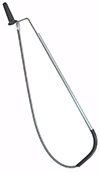Toilets across the GTA get plugged daily as a result of any number of factors. Infrequent flushing, use of too much toilet paper, or disposal of paper towels and other foreign matter in the toilet can all lead to a blockage. A clogged-up toilet is unpleasant and unhealthy, and usually happens when it’s least convenient for you. You may be able to unclog a toilet yourself, using the instructions given here. First, wait for the water level in the toilet to subside. If it drains without any help, try flushing the toilet again. It may be all you need to clear the blockage. If not, or if after you flush the water level remains high, you may need tools to clear it.
Plungers
The simplest way to unblock a toilet is to use a plunger, which is available from most local hardware stores. The traditional toilet plunger is bigger than a sink plunger and has an upside-down rubber bowl attached to a metal or wooden handle. The bowl-shaped section forces air into the toilet, and when it is pulled out it creates suction that may dislodge the blockage. Modern plastic plungers are designed with a concertina-shaped section at the end of the handle that compresses air when it is pressed. Working this up and down creates a pump action that forces air and water to move around the pan.
Before you try to unblock a toilet using a plunger, cover the floor around the toilet with newspaper or old towels to help mop up any spillage. Insert the plunger gently into the toilet and work it up and down a few times. If the water fails to subside, empty the contents of the toilet into a bucket using a jug or other receptacle. Wear disposable gloves if you have them, to avoid coming into contact with the contents of the toilet. Once only a little water is left in the toilet bowl, try the plunger again. If the blockage refuses to budge, try pouring a bucket of hot water down the toilet.
Augers

Although plenty of websites recommend using a mop to unblock a toilet, this is not an ideal way to do so. The mop is unlikely to reach much further than the plunger and may damage the toilet in the process. In addition, if you do manage to push it into the toilet bend it may break, and getting the mop head out will be very difficult. The next step would be to use a toilet auger, which is a flexible metal wire tool with a handle made to unblock a toilet. You can feed the wire into the toilet and determine where the blockage is located. The auger may be able to loosen or break up the plug, or you might be able to pull it out of the bend and back into the toilet. After that, you can remove it from the toilet and dispose of it in your garbage.
When to call a plumber
If you still have a blockage after you have tried these methods to unblock a toilet, the blockage could be caused by a backed-up sewer drain. Call a professional plumber to inspect your drains and identify the problem, and to determine whether you or the local authorities are responsible for the costs of repair.


Most blockages can be fixed with a plunger. If things still aren’t cleared up after multiple tries you can call a plumber. It’s better to pay and have it fixed properly than cause more damage.
Most blockages can be fixed with a plunger. If things still aren’t cleared up after multiple tries you can call a plumber. It’s better to pay and have it fixed properly than cause more damage.
Most blockages can be fixed with a plunger. If things still aren’t cleared up after multiple tries you can call a plumber. It’s better to pay and have it fixed properly than cause more damage.
Better info on your blog than what I have seen so far elsewhere. Thanks for sharing and… Keep up the good work. I know from experience it’s not always easy! :-).
Better info on your blog than what I have seen so far elsewhere. Thanks for sharing and… Keep up the good work. I know from experience it’s not always easy! :-).
Better info on your blog than what I have seen so far elsewhere. Thanks for sharing and… Keep up the good work. I know from experience it’s not always easy! :-).